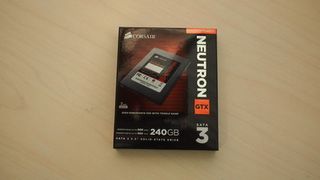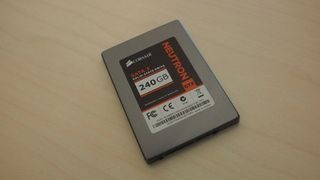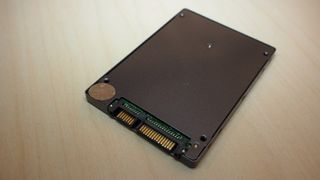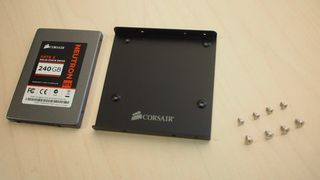TechRadar Verdict
Pros
- +
Terrific consumer-level performance
- +
Good price-per-GB ratio via online vendors
- +
Zippy performance via new LM87800 controller chip and stable firmware
Cons
- -
Not built for enterprise-level work
- -
MSRP over $50 higher than online vendor price, users will want to shop around
Why you can trust TechRadar
Sometimes blazing speed must be seen to be believed. Like an athlete at the top of their game, a cheetah tackling a gazelle on "National Geographic," or a Formula 1 race, witnessing it makes you realize why people dig deep into their pockets to watch a single person perform.
This is how we felt reviewing Corsair's Neutron GTX solid state drive.

We know the Corsair brand as a manufacturer of reliable RAM chips, and our friends swear by their logic boards, but the company seems to have cautiously entered the SSD marketplace. Corsair's SSD from last year, the Force 3 SSD, had issues with its SandForce controller chip that prompted a recall.
We couldn't detect any such problems with the Neutron GTX, but just to be safe the drive is backed with a five year warranty. Corsair seems to have put its focus on finding a new, non-problematic controller sans overheating or Blue Screen-triggering issues.

The LM87800 controller chip is the heart of the Neutron GTX drive. The LM8700, which sports two ARM cores and a 24nm Toshiba Toggle NAND, handles both its data transactions as well as the NAND and FTL (Flash Translation Layers, not Faster Than Light), thereby managing its basic operating functions and keeping itself going.
Installation proved to be as easy as could be hoped for and after unpacking the drive, mounting it in an external USB casing, formatting it with the Disk Utility program, cloning our data over to it, opening our mid-2011 13-inch MacBook Pro, swapping drives, closing the drive up and booting it, the screen sprung to life and all the files were exactly where they should have been. The only difference at hand was a marked increase in speed (the computer now booting in approximately 27 seconds and shutting down in approximately 20 seconds whereas with the previous hard drive – a Western Digital Scorpio Blue – we could expect to wait well over a minute on boot and over 30 seconds for the computer to turn off.

Performance
In terms of everyday disk use, the difference between a stock SATA hard drive and the Neutron GTX is like night and day. Previous disk-intensive tasks and applications such as opening Microsoft Word, Adobe Photoshop CS5, StarCraft II and repairing disk permissions complete within seconds, the computer now acting like a caffeinated puppy that's retrieved a ball and looks to you wondering when you're going to throw it again. The drive itself runs as quietly as could be hoped for and the temperature, which rose slightly when a headier app such as Photoshop was run, never went up to the temperatures found when using a standard SATA drive. Where standard read and write test scores were concerned, the drive clocked in a 496.7 MB/s read score and a 426.7 MB/s write score. Not the absolute top of the line, but more than enough to feel zippy for almost all run of the mill tasks.
The SSD price wars have begun in earnest and with a few years having passed since solid-state drives came on the market and users began paying top dollar for small capacity drives due to their "whiz-bang" factor. The push is now on to deliver more capacity for the buck. Here, the Neutron GTX stands in good stead and while its MSRP of $304.99 on the Corsair web site makes one wince a tiny bit ($1.27/£.87) per gigabyte), the price-to-storage ratio becomes easier if you buy it for the current list price of $239.99 off either Amazon.com or Newegg.com ($0.99 per gigabyte). While this doesn't make for the best SSD deal on the market, it becomes easier to digest and you still feel as if you're getting some bang for your buck.
Even though the Neutron GTX never broke 500 MB/s in standard read/write testing, the unit is both speedy and big. It will be a welcome relief for anyone who's wanted to get away from a conventional SATA drive with moving parts. While this might not be the very best choice to put in an enterprise-level machine and/or run as a server, the Neutron GTX was easily installed in a MacBook Pro and made everyday functions scream.

It's the little things that make a difference and Corsair has added some nice touches with its packaging and supplemental features. The Neutron GTX arrives with a sturdy black metal conversion bracket and eight screws to let it comfortably fit in any 3.5" drive slot. A small printed card outlines Corsair's five year warranty on the drive and includes information on who to contact, how to make a claim and where to send the drive if the unit proves defective. A nice touch, and it's worth putting away in a desk drawer after you unwrap the drive from its box.
We liked
Most importantly, it's fast. With read and write speeds topping out in the 400's, it's among the quickest solid state drives on the market. At 240GB it's also one of the largest. Finally, it was easy to install. We appreciate that Corsair packaged it with a bracket and screws right in the box.
We didn't like
Not a whole lot. It's expensive, but that goes with the territory of new, high-end gear. We'd say you're getting what you pay for, but it's strange that the MSRP has already been undercut by $50 from most online vendors in the U.S. Not a big deal though, just make sure you shop around. Ultimately, this is a very good consumer level SSD.
Verdict
From an IT professional/systems administrator perspective, the Neutron GTX is impressive, speedy but not remarkable. However, it trumped its competitors on sequential write tests. For the consumer looking to make the jump to from a standard SATA drive to an SSD, the time has never been better. Corsair has taken its time, put something interesting together with a great new controller chip and a good set of firmware backing it. In the end, the company has delivered a solid, speedy SSD with none of the bugs that troubled the SandForce-based Force 3 units. If you're looking to dive into the SSD ocean but need a drive of a decent size, we'd say the waters at Corsair are looking fine.
